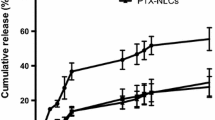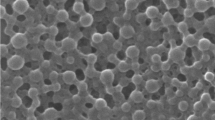Abstract
The aim of this research was to advance solid lipid nanoparticle (SLN) preparation methodology by preparing glyceryl monostearate (GMS) nanoparticles using a temperature-modulated solidification process. The technique was reproducible and prepared nanoparticles without the need of organic solvents. An anticancer agent, 5-fluorouracil (5-FU), was incorporated in the SLNs. The SLNs were characterized by particle size analysis, zeta potential analysis, differential scanning calorimetry (DSC), infrared spectroscopy, atomic force microscopy (AFM), transmission electron microscopy (TEM), drug encapsulation efficiency, in vitro drug release, and in vitro cell viability studies. Particle size of the SLN dispersion was below 100 nm, and that of redispersed lyophilizates was ~500 nm. DSC and infrared spectroscopy suggested that the degree of crystallinity did not decrease appreciably when compared to GMS. TEM and AFM images showed well-defined spherical to oval particles. The drug encapsulation efficiency was found to be approximately 46%. In vitro drug release studies showed that 80% of the encapsulated drug was released within 1 h. In vitro cell cultures were biocompatible with blank SLNs but demonstrated concentration-dependent changes in cell viability to 5-FU-loaded SLNs. The 5-FU-loaded SLNs can potentially be utilized in an anticancer drug delivery system.








Similar content being viewed by others
References
del Pozo-Rodriguez A, Delgado D, Gascon A, Solinis M. Lipid nanoparticles as drug/gene delivery systems to the retina. J Ocul Pharmacol Ther. 2013;29(2):173–88.
Genc L, Dikmen G, Guney G. Formulation of nano drug delivery systems. J Mater Sci Eng A. 2011;1(1):132–7.
Pradhan M, Singh D, Singh M. Novel colloidal carriers for psoriasis: current issues, mechanistic insight and novel delivery approaches. J Control Release. 2013;170(3):380–95.
Mehnert W, Mäder K. Solid lipid nanoparticles: production, characterization and applications. Adv Drug Deliv Rev. 2001;47(2–3):165–96.
Basu B, Garala K, Bhalodia R, Joshi B, Mehta K. Solid lipid nanoparticles: a promising tool for drug delivery system. J Pharm Res. 2010;3(1):84–92.
Alukda D, Sturgis T, Youan B-BC. Formulation of tenofovir-loaded functionalized solid lipid nanoparticles intended for HIV prevention. J Pharm Sci. 2011;100(8):3345–56.
Qi J, Lu Y, Wu W. Absorption, disposition and pharmacokinetics of solid lipid nanoparticles. Curr Drug Metab. 2012;13(4):418–28.
Li XW, Lin XH, Zheng LQ, Yu L, Lv FF, Zhang QQ, et al. Effect of poly(ethylene glycol) stearate on the phase behavior of monocaprate/Tween80/water system and characterization of poly(ethylene glycol) stearate-modified solid lipid nanoparticles. Colloids Surf A Physicochem Eng Asp. 2008;317(1–3):352–9.
Siekmann B, Westesen K. Investigations on solid lipid nanoparticles prepared by precipitation in o/w emulsions. Eur J Pharm Biopharm. 1996;42(2):104–9.
Reddy LH, Sharma RK, Chuttani K, Mishra AK, Murthy RSR. Influence of administration route on tumor uptake and biodistribution of etoposide loaded solid lipid nanoparticles in Dalton’s lymphoma tumor bearing mice. J Control Release. 2005;105(3):185–98.
Cavalli R, Caputo O, Gasco MR. Preparation and characterization of solid lipid nanospheres containing paclitaxel. Eur J Pharm Sci. 2000;10(4):305–9.
Serpe L, Catalano MG, Cavalli R, Ugazio E, Bosco O, Canaparo R, et al. Cytotoxicity of anticancer drugs incorporated in solid lipid nanoparticles on HT-29 colorectal cancer cell line. Eur J Pharm Biopharm. 2004;58(3):673–80.
Howlader N NA, Krapcho M, Neyman N, Aminou R, Waldron W, Altekruse SF, Kosary CL, Ruhl J, Tatalovich Z, Cho H, Mariotto A, Eisner MP, Lewis DR, Chen HS, Feuer EJ, Cronin KA, Edwards BK (Eds). SEER cancer statistics review 1975–2008. Bethesda, MD: National Cancer Institute, NIH, DHHS.
Cancer Trends Progress Report—2009/2010 update. Bethesda, MD: National Cancer Institute, NIH, DHHS, April 2010.
Carethers JM, Smith EJ, Behling CA, Nguyen L, Tajima A, Doctolero RT, et al. Use of 5-fluorouracil and survival in patients with microsatellite-unstable colorectal cancer. Gastroenterology. 2004;126(2):394–401.
Sander CA, Pfeiffer C, Kligman AM, Plewig G. Chemotherapy for disseminated actinic keratoses with 5-fluorouracil and isotretinoin. J Am Acad Dermatol. 1997;36(2):236–8.
Longley DB, Johnston PG. 5-Fluorouracil. Apoptosis, cell signaling, and human diseases. 2007:263–78.
Diasio RB, Harris BE. Clinical pharmacology of 5-fluorouracil. Clin Pharmacokinet. 1989;16(4):215–37.
Prince LM. Microemulsions versus micelles. J Colloid Interface Sci. 1975;52(1):182–8.
Zhang J, Fan Y, Smith E. Experimental design for the optimization of lipid nanoparticles. J Pharm Sci. 2009;98(5):1813–9.
Izutsu K, Kojima S. Excipient crystallinity and its protein-structure-stabilizing effect during freeze-drying. J Pharm Pharmacol. 2002;54(8):1033–9. Epub 2002/08/28.
Shahgaldian P, Gualbert J, Aissa K, Coleman AW. A study of the freeze-drying conditions of calixarene based solid lipid nanoparticles. Eur J Pharm Biopharm. 2003;55(2):181–4. Epub 2003/03/15.
Schwarz C, Mehnert W. Freeze-drying of drug-free and drug-loaded solid lipid nanoparticles (SLN). Int J Pharm. 1997;157(2):171–9. Epub 1999/09/09.
Heiati H, Tawashi R, Phillips NC. Drug retention and stability of solid lipid nanoparticles containing azidothymidine palmitate after autoclaving, storage and lyophilization. J Microencapsul. 1998;15(2):173–84.
Validation of analytical procedures: text and methodology Q2(R1). ICH Harmonised Tripartite Guideline: International Conference on Harmonisation of Technical Requirements for Registration of Pharmaceuticals for Human Use; 1994.
Singh S, Dobhal AK, Jain A, Pandit JK, Chakraborty S. Formulation and evaluation of solid lipid nanoparticles of a water soluble drug: zidovudine. Chem Pharm Bull. 2010;58(5):650–5.
Schubert MA, Mueller-Goymann CC. Characterisation of surface-modified solid lipid nanoparticles (SLN): influence of lecithin and nonionic emulsifier. Eur J Pharm Biopharm. 2005;61(1–2):77–86.
Cavalli R, Caputo O, Gasco MR. Solid lipospheres of doxorubicin and idarubicin. Int J Pharm. 1993;89(1):R9–R12.
Olbrich C, Gessner A, Kayser O, Muller RH. Lipid-drug-conjugate (LDC) nanoparticles as novel carrier system for the hydrophilic antitrypanosomal drug diminazenediaceturate. J Drug Target. 2002;10(5):387–96.
Wong HL, Bendayan R, Rauth AM, Wu XY. Development of solid lipid nanoparticles containing ionically complexed chemotherapeutic drugs and chemosensitizers. J Pharm Sci. 2004;93(8):1993–2008.
Wang J-X, Sun X, Zhang Z-R. Enhanced brain targeting by synthesis of 3′,5′-dioctanoyl-5-fluoro-2′-deoxyuridine and incorporation into solid lipid nanoparticles. Eur J Pharm Biopharm. 2002;54(3):285–90.
Heydenreich A, Westmeier R, Pedersen N, Poulsen H, Kristensen H. Preparation and purification of cationic solid lipid nanospheres—effects on particle size, physical stability and cell toxicity. Int J Pharm. 2003;254(1):83–7.
Yang SC, Zhu JB. Preparation and characterization of camptothecin solid lipid nanoparticles. Drug Dev Ind Pharm. 2002;28(3):265–74.
del Pozo-Rodriguez A, Solinis MA, Gascon AR, Pedraz JL. Short- and long-term stability study of lyophilized solid lipid nanoparticles for gene therapy. Eur J Pharm Biopharm. 2009;71(2):181–9.
Asasutjarit R, Lorenzen S-I, Sirivichayakul S, Ruxrungtham K, Ruktanonchai U, Ritthidej GC. Effect of solid lipid nanoparticles formulation compositions on their size, zeta potential and potential for in vitro pHIS-HIV-hugag transfection. Pharm Res. 2007;24(6):1098–107.
de Faria TJ, Souza-Silva E, de Oliveira DT, Senna Elenara L, Tonussi CR. Evaluation of the pro-inflammatory potential of nanostructured drug carriers in knee-joints of rats: effect on nociception, edema, and cell migration. J Pharm Sci. 2009;98(12):4844–51.
Li Z, Yu L, Zheng L, Geng F. Studies on crystallinity state of puerarin loaded solid lipid nanoparticles prepared by double emulsion method. J Therm Anal Calorim. 2010;99(2):689–93.
Yassin Alaa Eldeen B, Anwer Md K, Mowafy Hammam A, El-Bagory Ibrahim M, Bayomi Mohsen A, Alsarra Ibrahim A. Optimization of 5-fluorouracil solid-lipid nanoparticles: a preliminary study to treat colon cancer. Int J Med Sci. 2010;7(6):398–408.
Sussich F, Bortoluzzi S, Cesàro A. Trehalose dehydration under confined conditions. Thermochim Acta. 2002;391(1):137–50.
Simperler A, Kornherr A, Chopra R, Bonnet PA, Jones W, Motherwell WDS, et al. Glass transition temperature of glucose, sucrose, and trehalose: an experimental and in silico study. J Phys Chem B. 2006;110(39):19678–84.
Wartewig S, Neubert RHH. Pharmaceutical applications of Mid-IR and Raman spectroscopy. Adv Drug Deliv Rev. 2005;57(8):1144–70.
Lin X, Li X, Zheng L, Yu L, Zhang Q, Liu W. Preparation and characterization of monocaprate nanostructured lipid carriers. Colloids Surf A Physicochem Eng Asp. 2007;311(1–3):106–11.
Liu D, Ge Y, Tang Y, Yuan Y, Zhang Q, Li R, et al. Solid lipid nanoparticles for transdermal delivery of diclofenac sodium: preparation, characterization and in vitro studies. J Microencapsul. 2010;27(8):726–34.
Li XM, Xu YL, Chen GG, Wei P, Ping QN. PLGA nanoparticles for the oral delivery of 5-fluorouracil using high pressure homogenization-emulsification as the preparation method and in vitro/in vivo studies. Drug Dev Ind Pharm. 2008;34(1):107–15.
Jain SK, Chaurasiya A, Gupta Y, Jain A, Dagur P, Joshi B, et al. Development and characterization of 5-FU bearing ferritin appended solid lipid nanoparticles for tumour targeting. J Microencapsul. 2008;25(5):289–97.
Glavas-Dodov M, Fredro-Kumbaradzi E, Goracinova K, Simonoska M, Calis S, Trajkovic-Jolevska S, et al. The effects of lyophilization on the stability of liposomes containing 5-FU. Int J Pharm. 2005;291(1):79–86.
Matsumura Y, Maeda H. A new concept for macromolecular therapeutics in cancer chemotherapy: mechanism of tumoritropic accumulation of proteins and the antitumor agent smancs. Cancer Res. 1986;46(12, Pt. 1):6387–92.
Gokce EH, Sandri G, Bonferoni MC, Rossi S, Ferrari F, Gueneri T, et al. Cyclosporine A loaded SLNs: evaluation of cellular uptake and corneal cytotoxicity. Int J Pharm. 2008;364(1):76–86.
Olbrich C, Kayser O, Mueller RH. Enzymatic degradation of Dynasan 114 SLN—effect of surfactants and particle size. J Nanoparticle Res. 2002;4(1/2):121–9.
Olbrich C, Kayser O, Muller RH. Lipase degradation of Dynasan 114 and 116 solid lipid nanoparticles (SLN)—effect of surfactants, storage time and crystallinity. Int J Pharm. 2002;237(1–2):119–28.
Nomura DK, Lombardi DP, Chang JW, Niessen S, Ward AM, Long JZ, et al. Monoacylglycerol lipase exerts dual control over endocannabinoid and fatty acid pathways to support prostate cancer. Chem Biol. 2011;18(7):846–56. Cambridge, MA, United States.
Nomura DK, Long JZ, Niessen S, Hoover HS, Ng S-W, Cravatt BF. Monoacylglycerol lipase regulates a fatty acid network that promotes cancer pathogenesis. Cell. 2010;140(1):49–61. Cambridge, MA, United States.
Eytan GD, Regev R, Oren G, Hurwitz CD, Assaraf YG. Efficiency of P-glycoprotein-mediated exclusion of rhodamine dyes from multidrug-resistant cells is determined by their passive transmembrane movement rate. Eur J Biochem. 1997;248(1):104–12.
Guo H, Hao R, Wei Y, Sun D, Sun S, Zhang Z. Optimization of electrotransfection conditions of mammalian cells with different biological features. J Membr Biol. 2012;245(12):789–95.
Olbrich C, Gessner A, Schroder W, Kayser O, Muller RH. Lipid-drug conjugate nanoparticles of the hydrophilic drug diminazene-cytotoxicity testing and mouse serum adsorption. J Control Release Off J Control Release Soc. 2004;96(3):425–35.
Acknowledgments
This research was performed with support from start-up funds made available by the Department of Pharmacy Practice at the University of Toledo College of Pharmacy and Pharmaceutical Sciences. We are grateful to Dr. Joseph Lawrence, Center for Sensor and Materials Characterization, University of Toledo College of Engineering, for his assistance during the TEM work. We thank Ms. Charisse Montgomerry, Scientific Editor and College Communicator, College of Pharmacy and Pharmaceutical Sciences, University of Toledo, for her review and comments.
Conflict of Interest
The authors report no conflict of interest.
Author information
Authors and Affiliations
Corresponding author
Additional information
Guest Editors: Mahavir B. Chougule and Chalet Tan
Rights and permissions
About this article
Cite this article
Patel, M.N., Lakkadwala, S., Majrad, M.S. et al. Characterization and Evaluation of 5-Fluorouracil-Loaded Solid Lipid Nanoparticles Prepared via a Temperature-Modulated Solidification Technique. AAPS PharmSciTech 15, 1498–1508 (2014). https://doi.org/10.1208/s12249-014-0168-x
Received:
Accepted:
Published:
Issue Date:
DOI: https://doi.org/10.1208/s12249-014-0168-x




